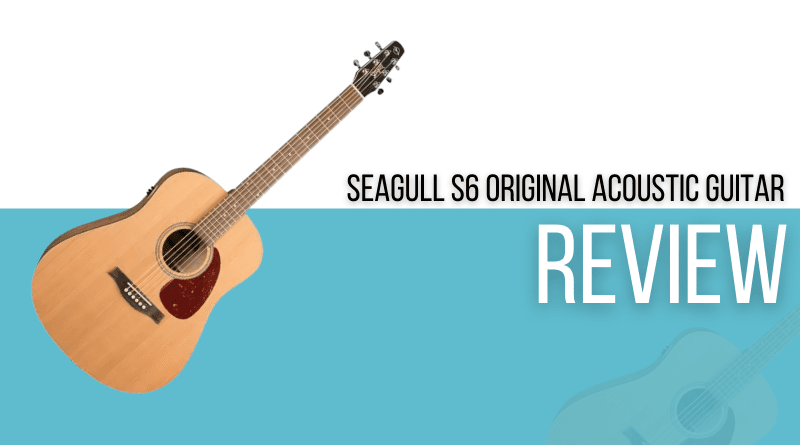Seagull’s S6 dreadnought bedazzled the acoustic guitar community with its rich, warm sound and melodious overtones. We put it through the wringer to see if this instrument from the hinterland of Canada lives up to the eulogy and awards it has received.
Seagull’s motto has been to create highly affordable instruments with better structural integrity and sound than its competitors. True that cause, beneath the mild-mannered aesthetic, they have concealed some stellar engineering accomplishments in the traditional guitar architecture.
The peculiar headstock shape, for instance, has tuning machines in line with the nut for better tuning stability. They also pioneered the use of thin, lightly braced tops with a ‘compound-curve’ to improve stability without deviating from the typical dreadnought tone we’re accustomed to.
Seagull came knocking on a highly crowded market with the S6 Original with that same promise of reliable construction, excellent tonewoods, and a price that has disheveled the competition. It’s a part of the award-winning S6 Series lineup that also features models like the S6 Classic Black A/E, S6 Burnt Umber QIT (Spruce top w/ QIT Electronics), and S12 Concert Hall CW.
I’ll review the S6 Original in this post alongside possible upgrades, accessories recommendations, and other models to consider.
Read more about our review process.
Contents
Seagull S6 Original: Who is it for?
From Clapton’s ‘Layla’ to Taylor Swift’s ‘Betty’, the S6 Original sounds radiant, mature, and loud. As long as your personal taste aligns with the tone, S6 Original is a worthy investment for guitarists at any level of skill and expertise. The guitar is also available in a left-handed version.
In particular, The S6 serves as an affordable, high-quality option for beginner-to-intermediate guitar players. It can also double up as a trusty backup guitar for rehearsals and home recordings. However, it will not satiate the expectations of expert guitarists and touring professionals.
Seagull S6 Original: Appearance / Features / Controls
The S6 Original scores full points for build quality and construction. The craftsmanship does justice to ethically sourced tonewoods and high-quality components. The S6 Series features a modified body and headstock shape for enhanced resonance and improved performance.
Visually, the pressure-tested solid Cedar top prettily contrasts the darker three-layered laminate Canadian Wild Cherry body. The tapered headstock is more than a visual gimmick. It is, as Godin Guitars claims, designed to provide added tuning stability.
Similarly, the TUSQ nut and compensated saddle are designed to improve performance. The double truss rod beneath the Silver Leaf Maple neck will ensure an easy setup and corrections when needed (read this if you’re not familiar with truss rods).
The scale length clocks 25.6-inches (more on scale length here) and the rosewood fingerboard houses 21 frets with classic dot inlays. The 45mm (1.8-inch) nut-width might feel a tad too wide for people with small hands or stature. However, Seagull offers the S6 Slim (43mm nut width) to cater to that population.
Overall, the action and playability are as good as guitars twice the price. Other noteworthy features include the light X bracing, the integrated set neck, and an ultra-thin semi-gloss finish for rich overtones.

Seagull S6 Original: Performance / Sound
Cedar is commonly used in classical (nylon string) guitars because of its dense grain and warm tone. The S6 Original shares that virtue – made apparent by a darker and lush tonal palette. The sound is rich in overtones with a good deal of clarity and character.
Wild Cherry and Silver Leaf Maple are relatively uncommon tonewoods. To put things into perspective, Wild Cherry is known to add note definition and warmer than maple but more crisp than mahogany. The combination of tonewoods suits a variety of styles and genres.
The projection is loud with great sustain. It lends well to jangly strumming, which sounds thick and full-bodied with a fat low-end. The resonance has some twang too, and the modified dreadnought shape thwarts any boominess in the lows. If anything, the low-end may feel a little too focused, which detracts from the overall balance.
The responsive tone and focused bottom end of the S6 Original come to life as you fingerpick songs like The Beatles’ ‘Blackbird’ and John Mayer’s ‘Stop This Train’. The broad neck has sufficient room to maneuver while the crisp mids and highs sound great with fingerstyle playing.
Seagull S6 Electronics (for the Q1 version):
The S6 Original has no electronics. For that, you need a Seagull S6 QIT acoustic-electric version. It is essentially the same guitar fitted with Godin’s EPM Quantum preamp and pickup system. I do advise to ‘future proof’ if your budget allows it, as the upgrade only costs an extra 60 bucks.
Since that is the only distinguishing factor, I’ll throw some shade on it to make this an all-encompassing review. The Quantum electronic runs on a 9v battery and consists of an on-board tuner, an under-saddle pickup, and a preamp to control volume, bass, and treble.
The chromatic tuner and LED display are on point. The EQ on the QIT (formerly known as QI) is responsive enough to milk some good tones from it. Overall, the Seagull S6 QI sounds great plugged in. It can be used for small-to-medium sized venues and modest studio recordings.
Value: Is Seagull S6 Original worth the money?
The Seagull S6 Original stands tall in this price segment by delivering excellent value, tone, and performance. Moreover, the guitar ages well and can be improved upon with some inexpensive upgrades. It is highly recommended for beginner-to-advanced acoustic guitarists, singer-songwriters, and fingerpicking enthusiasts.
The guitar gives you more reasons to play it than contemplate how it holds its value in the used market. Nevertheless, an S6 won’t fetch you a good resale price because it does not command the same reverence as Taylor, Martin, or Gibson.
This video demonstrates the capabilities of the Seagull S6 Original:
Other models to consider
The only reason to consider other models is a) you have a bigger budget, b) you don’t fancy the Cedar tone, and c) you are a more advanced player who needs a guitar with a solid body.
Luckily, Seagull has covered most of those demands in the other models of the S6 Series. The S6 Original has a full-sized body and can feel quite chunky for kids or people with a small stature. In that case, I recommend the nearly identical S6 Original Slim model.
If you prefer a solid Spruce top to pressure-tested Cedar, you can get an S6 Original Burnt Umber. They also offer the S6 Classic Black A/E with a black finish, white tortoise pickguard, and blackwashed back. It also features an arguably better Fishman Sonitone preamp system.
Recommended accessories/Upgrades:
Guitar Strings: While the stock strings sound fine, I eventually swapped them with a thicker gauge Elixir Nanoweb Phosphor Bronze Medium (.013 – 0.56) to tame the high end. It is a matter of personal preference. The general idea is to use thicker string for more bass and less treble.
If you are in the mood to experiment, I highly recommend the Martin MA130S Silk & Steel Acoustic Strings. They are well suited for genres such as indie/folk , fingerstyle blues, and country.
Gig Bag: You will need an acoustic gig bag for safe storage and transport. The Seagull Standard Gig Bag is the obvious choice as it is tailor-made for these guitars. If you want other options, you can catch up on our best acoustic gig bag roundup.
Nut/Saddle: You can replace the TUSQ nut with a high-quality bone nut. It’s an optional upgrade that can improve the resonance and result in an open sounding tone. Although, the marginal improvement in tone may or may not justify the cost of the upgrade.
Here are some additional links to buy useful add-ons for the Seagull S6 Original:
- Seagull Suede Guitar Strap (Standard)
- Seagull Leather Guitar Strap (Premium)
- Seagull Pro G Stand for Acoustic Guitar (solid African Sapele hardwood)
Final Thoughts on the Seagull S6 Original
Every once in a while, an underdog surfaces in the food chain to reshuffle the pecking order. The Seagull S6 Original is one of them, and for good reasons. You know we’re nitpicking when we list ‘no gig bag included’ in the cons of a competitively priced guitar.
You can use the spare cash to invest in a solid guitar stand or wall mount. We’ve handpicked the best ones in our ‘best guitar stands/racks roundup‘ and best guitar wall mount post.
Check out these other awesome acoustic guitar articles:

